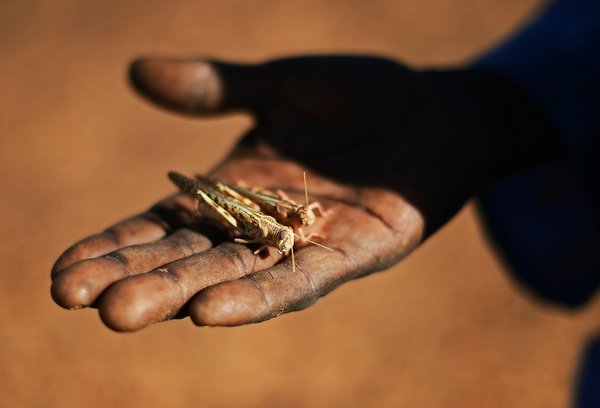- Share this article
- Subscribe to our newsletter
Desert Locust outbreak
Heavy rains and cyclones have triggered a recent surge in Desert Locust populations, causing an outbreak to develop in Sudan and Eritrea that is rapidly spreading along both sides of the Red Sea to Saudi Arabia and Egypt, FAO warned in mid-February 2019. The UN agency called on all the affected countries to step-up vigilance and control measures to contain the destructive infestations and protect crops from the world's most dangerous migratory pest.
Desert Locusts are a major threat to crop production. Adult locust swarms can fly up to 150 km a day with the wind. Female locusts can lay 300 eggs within their lifetime while an adult insect can consume roughly its own weight in fresh food per day - about two grams every day. A very small swarm eats the same amount of food in one day as about 35,000 people and the devastating impact locusts can have on crops poses a major threat to food security, especially in already vulnerable areas.
Substantial increase in locust populations
Good rains along the Red Sea coastal plains in Eritrea and Sudan have allowed two generations of breeding since October, leading to a substantial increase in locust populations and the formation of highly mobile swarms. At least one swarm crossed the Red Sea to the northern coast of Saudi Arabia in mid-January, followed by additional migrations about one week later. Groups of mature winged adults and a few swarms also moved north along the coast to southeast Egypt at the end of the month.
In the interior of Saudi Arabia, two generations of breeding also occurred in the south-eastern Empty Quarter region near the Yemen-Oman border after unusually good rains from cyclones Mekunu and Luban in May and October 2018 respectively. A few of these swarms have already reached the United Arab Emirates (UAE) and southern Iran, with a potential risk of spreading further towards the India-Pakistan border.
Breeding will continue in February on the Red Sea coast in Sudan and Eritrea, causing a further increase in hopper and adult groups, hopper bands and adult swarms. As vegetation dries out, adult groups and a few swarms are likely to move north along the Red Sea coast in Eritrea to Sudan, and from the Red Sea coast of Sudan to the Nile Valley in northern Sudan. There is a moderate risk that some swarms will continue crossing the Red Sea to the coastal and interior areas of Saudi Arabia.
Next three months will be critical
It is important to bring the locust situation under control before the summer breeding starts, FAO experts point out. According to them, the further spread of the current outbreak depends on two major factors: effective control and monitoring measures in locust-breeding areas of Sudan, Eritrea and Saudi Arabia and the surrounding countries, as well as rainfall intensity between March and May along both sides of the Red Sea and in the interior of the Arabian Peninsula.
Aerial spraying operations were mounted in Sudan and Saudi Arabia, supplemented by ground control measures in both countries, as well as in Eritrea and Egypt, treating more than 80,000 ha since December.
(FAO/ile)





Add a comment
Be the First to Comment